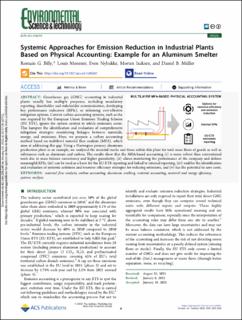| dc.description.abstract | Greenhouse gas (GHG) accounting in industrial plants usually has multiple purposes, including mandatory reporting, shareholder and stakeholder communication, developing key performance indicators (KPIs), or informing cost-effective mitigation options. Current carbon accounting systems, such as the one required by the European Union Emission Trading Scheme (EU ETS), ignore the system context in which emissions occur. This hampers the identification and evaluation of comprehensive mitigation strategies considering linkages between materials, energy, and emissions. Here, we propose a carbon accounting method based on multilevel material flow analysis (MFA), which aims at addressing this gap. Using a Norwegian primary aluminum production plant as an example, we analyzed the material stocks and flows within this plant for total mass flows of goods as well as substances such as aluminum and carbon. The results show that the MFA-based accounting (i) is more robust than conventional tools due to mass balance consistency and higher granularity, (ii) allows monitoring the performance of the company and defines meaningful KPIs, (iii) can be used as a basis for the EU ETS reporting and linked to internal reporting, (iv) enables the identification and evaluation of systemic solutions and resource efficiency strategies for reducing emissions, and (v) has the potential to save costs. | en_US |

